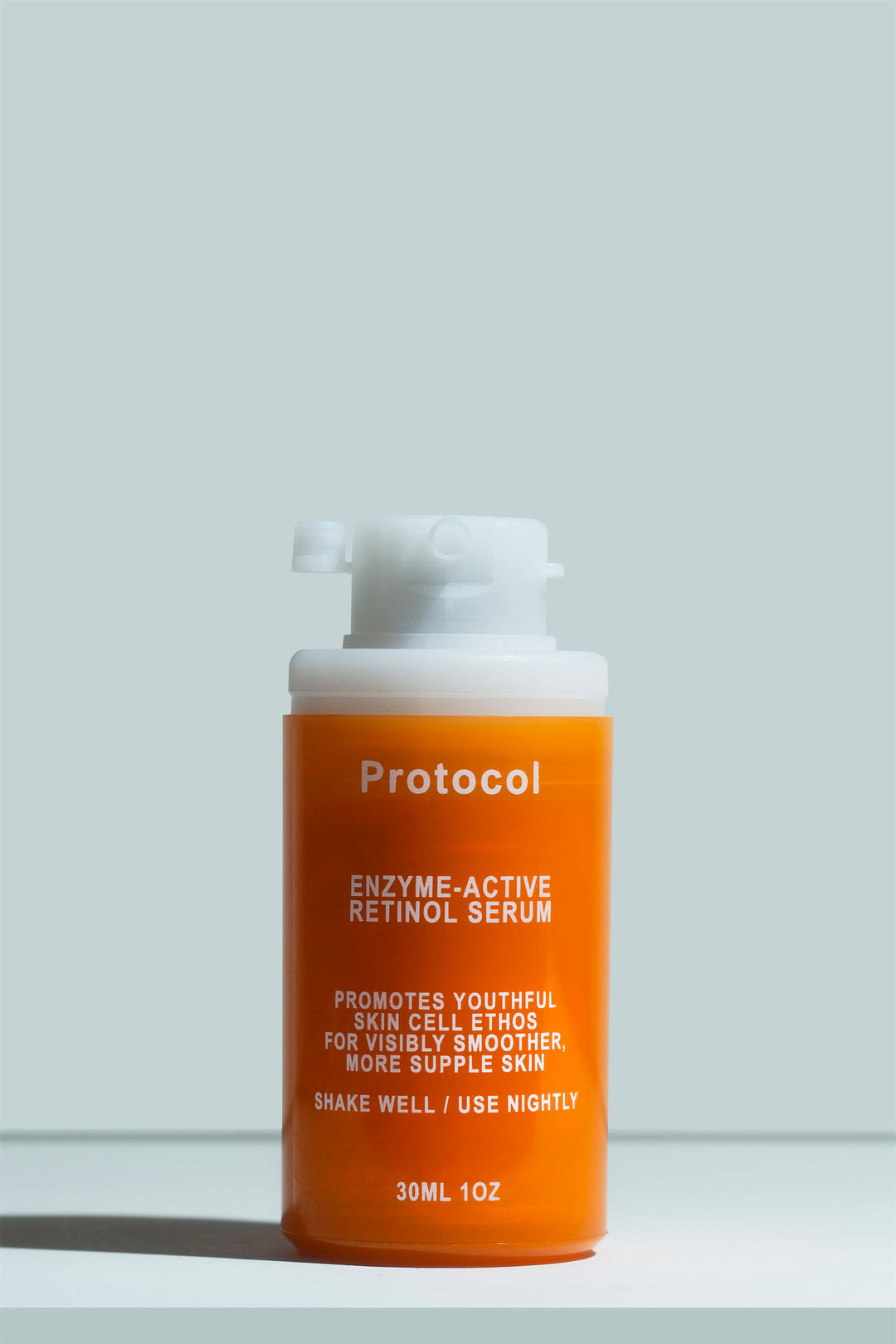Can You Use Hyaluronic Acid With Retinol?

Retinol and hyaluronic acid are the two most hyped-up ingredients in the skincare world, and frankly, their reputation is well-earned.
Nothing beats retinol’s anti-aging effects, while hyaluronic acid is unmatched in its ability to hydrate. If you want to take the best care of your skin, it makes sense to wonder if you can use hyaluronic acid with retinol, and if so, how?
Let's explore this topic in detail. In this post, we’ll cover the benefits of hyaluronic acid and retinol, separately and when used together. We’ll explain how to use them together, with a sample routine and some product-buying tips.
What is hyaluronic acid?
Hyaluronic acid (HA) has been the skincare world’s favorite hydrating agent for a long time now. It’s a powerful humectant, which means it can absorb and hold onto water. There are plenty of humectants in skincare, but two factors make hyaluronic acid unique.
First, it’s powerful — a small amount is enough to significantly amp up the hydrating powers of any moisturizer or serum. Second, it has a pretty high affinity for human skin. Our bodies produce hyaluronic acid naturally, and it occurs as part of the skin’s extracellular matrix. It floats in between our skin cells, both in the epidermis and dermis, keeping the skin soft, strong, and supple.
As we get older, our body’s production of hyaluronic acid slows down (along with the production of many other important components). This is why the skin gets drier with age.
In skincare products, hyaluronic acid infuses the skin with moisture. Through increased hydration, hyaluronic acid plumps up the skin, tightening the epidermis from below. This is how HA improves other factors related to skin appearance, such as diminishing fine lines, enhancing skin luminosity, and reducing pore size and texture.
At Protocol, you can find hyaluronic acid in a few of our products, including our Hyaluronic Acid and Niacinamide Hydration Cream and Water Lock, our latest skin-rescuing release.
What is retinol?
Retinol is the anti-aging superstar of the skincare world. This ingredient belongs to a whole family of different types of retinoids, which are molecules related to vitamin A. They trigger receptors that tell fibroblasts in the lower layers of the dermis to speed up their action, resulting in fast skin renewal.
It’s the secret to correcting just about any skin imperfection. Retinoids are proven to increase collagen production, resulting in a visible reduction in wrinkles and fine lines. Beyond that, retinoids can also help with blemishes and clogged pores (some are even considered acne medications), discoloration, scarring, skin texture, and more.
At Protocol, we use retinal, which is short for retinaldehyde. Most cosmetic or OTC retinol products are made with retinal’s precursor, retinol. When applied to the skin, retinol converts into retinal and then it converts into retinoic acid.
This dual conversion process robs retinol of a lot of its potential power. Retinal, on the other hand, only needs one conversion step. Research shows that it retains a lot of the same effects as applying retinoic acid to the skin but with significantly less irritation. That’s why it’s the star in our Enzyme-Active Retinol Serum.
How do retinol and hyaluronic acid compare?
It doesn’t make much sense to do a retinol vs hyaluronic acid comparison. The two ingredients function differently, with different effects and benefits. Plus, they’re very compatible, so there’s no reason to choose between one or the other. With that said, here’s a quick summary of their differences:
- Positive effects: Retinol has a skin-renewing effect that can repair a lot of damage and specific concerns including signs of aging, while hyaluronic acid is primarily a hydrating ingredient.
- Concerns targeted: Retinol can address wrinkles, loss of firmness, discoloration, skin texture, scarring, blemishes, and clogged pores. Hyaluronic acid can address dehydration and fine lines by plumping the skin up with moisture.
- Time to results: Retinol acts on a molecular level, so it takes a little longer to see signs that your retinol is working — results also depend on the strength and bioavailability of your retinol. Hyaluronic acid can moisturize the skin right away or over a few hours, depending on how it is formulated and other factors like humidity. Using it regularly over a few weeks helps improve skin quality until you reach a maximal level of hydration, assuming that the rest of your skincare routine is also on point.
- Skin type: Hyaluronic acid is suitable for all skin types, while retinol can be slightly irritating to those with sensitive skin (although it’s often worth enduring).
Benefits of using hyaluronic acid and retinol together
For anyone with a modern skincare routine, using both retinol and hyaluronic acid together makes perfect sense. The two are the ultimate glow-makers, and they’re ideal if you’re interested in achieving skin that looks smoother and healthier.
First of all, using both retinol and hyaluronic acid together allows you to tackle both long and short-term skin goals. Hyaluronic acid gives the skin some fast plumping action, to make it look youthful quickly. Retinol works over a few weeks or months to renew the skin. Seeing results takes longer, but the changes to the skin are a little more profound and long-lasting.
Additionally, your skin will tolerate retinol more easily if it’s well-hydrated. Research also shows that hyaluronic acid helps reduce the skin’s inflammatory response, which is another way it may help prevent irritation from retinol.
Is it safe to use retinol and hyaluronic acid together?
It’s perfectly safe to use retinol and hyaluronic acid together. The two ingredients work well together, and there is no need to worry about interactions or overwhelming the skin.
While it’s important to be careful when mixing retinol with other skin-renewing ingredients such as AHAs or vitamin C, hyaluronic acid isn’t an exfoliant or skin renewer. It has a mild ability to improve signs of aging, but not in a way that’s likely to sensitize the skin.
Some people do experience irritation as a result of using high amounts of hyaluronic acid in their routine, especially if they’re using more penetrative low-molecular weight hyaluronic acid. This isn’t because of over-exfoliation, though. Low molecular weight HA can be proinflammatory, and we believe it’s best avoided in skincare.
How to use retinol and hyaluronic acid together in your Protocol routine
There are a lot of ways to combine hyaluronic acid and retinol. With our formulas, we recommend using retinol at night, while products with hyaluronic acid can be used both morning and night. Here’s our ideal sample routine for maximum renewal in the evening:
- Start with damp skin. If needed, cleanse with the Double AHA Cleanser or any other gentle cleanser.
- With your skin still damp, apply a single pump of the Enzyme-Active Retinol Serum to your face and neck. Wait anywhere from 5 to 30 minutes to allow the serum to fully absorb.
- Finally, apply a layer of a moisturizer with hyaluronic acid, like our Niacinamide and Hyaluronic Acid Hydration Cream for maximum skin renewal or Water Lock, our mild formula for advanced occlusion and hydration.
- You can also apply both, in which case we recommend applying the Hydration Cream first followed by Water Lock.
Which do you apply first, retinol or hyaluronic acid?
The ingredient you apply first depends on your skin’s needs and goals. Whichever ingredient goes on your skin first will have the greater impact, and will somewhat dilute whatever you apply over it.
If you’re interested in experiencing the most of retinol’s skin-renewing action, it’s better to apply it first.
That said, for those just starting out or with sensitive skin, it might be better to apply hyaluronic acid first, followed by retinol. This is especially true if you’re using a powerful prescription retinoid with a higher risk of irritation.
The hyaluronic acid will “buffer” the retinol, meaning it will slow its rate of penetration, reducing the chances of irritation but also reducing its efficacy. Afterward, you can apply a moisturizer, which is called the “sandwich method” in skincare circles.
The other factor to consider is how your retinol and hyaluronic acid are formulated. If both are serums, they’ll be lighter and quicker to sink into the skin. If one is formulated as a cream and the other in a serum, it’s best to go thinnest to thickest, applying the serum first followed by the cream.
Considerations when shopping for hyaluronic acid and retinol products
When choosing products with hyaluronic acid or retinol, here are a few things we recommend you keep in mind:
- Retinol is better as a serum, since light, water-based formulas sink into the skin more deeply. You don’t need to be as picky with hyaluronic acid, which we prefer in comprehensive moisturizer formulas.
- Look for yellow retinol. The natural color of retinol is yellow-orange, so that’s a good sign that your product contains a sufficient amount of potent retinol.
- Retinoids are very delicate, so look for packaging that protects the formula from UV and oxygen.
Embrace the skin renewers
Retinol and hyaluronic acid might be the two biggest names in skincare, but that doesn’t mean that they’re similar. One is a strong active ingredient that stimulates skin cell renewal, boosting collagen and elastin. The other is a powerful humectant that helps the skin take in high amounts of water, for that instant plumpness and glow.
You can’t go wrong with both in your routine! They work well together, with hyaluronic acid to increase the skin’s hydration and resilience, and retinol to promote a long-term anti-aging effect. Together, the result is springy, plump, smooth, and youthful-looking skin. You can find both retinol and hyaluronic acid in our Skin Molecule Optimization Line, along with several other skin-transforming must-have ingredients.




